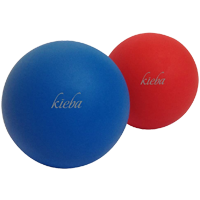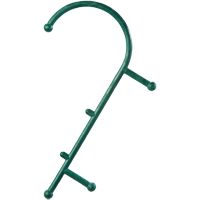The quadratus lumborum (QL) muscle connects the hip bone and the lower back vertebrae to the 12th rib.
The muscle is notorious for pain in the lower back, top of the hip, and buttocks that often extend down into the upper thigh. What is not as commonly known is the muscle can also refer to pain in the pelvis, groin, and lower abdomen.
QL pain can be debilitating. The pain is often sharp and stabbing when you move, cough or sneeze. The aching pain can be ever-present, not letting up whatever positions you may try. Laying on the floor or a very firm mattress may help reduce the pain, but you will still feel it.
Where Is The Quadratus Lumborum Muscle?

The quadratus lumborum is a low back muscle that connects the hip bone (iliac crest), lower back vertebrae (L1, L2, L3, L4) to the 12th rib.
For detailed anatomy information: Quadratus Lumborum Anatomy Page
What Does The Quadratus Lumborum Do?
- Side bending the trunk
- Straightening of the spine (standing straight)
- Stabilizes the low back
- Helps to raise the hip when you lift your thigh
- Assists with exhalation (breathing out)
- Supports and protects the internal organs
Interesting Facts:
- It is known as the ‘hip hiker’ muscle’ because it is the muscle that raises the hip (think of how you raise your hip to balance a child that you are carrying).
- Pain from the quadratus lumborum can be paralyzing. It brings a sharp stabbing knife-like pain to the lower back area. Turning over in bed and trying to stand from a sitting position can almost bring tears to the eyes.
- The quadratus lumborum muscle allows the separation of movement between the upper body and the lower body. Two examples are keeping the hips and legs still while moving and twisting the upper body and arms or moving the legs while keeping the upper body still.
- People who have one hip noticeably higher than the other are often experiencing problems with the quadratus lumborum.

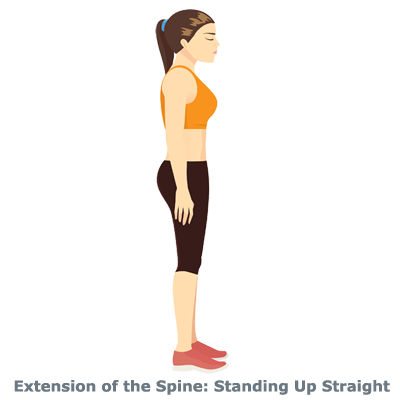
Quadratus Lumborum Muscles Pain Symptoms

QL muscle pain can make your life miserable. The pain is felt in the lower back, where the muscle connects to the top of the hip bone. The pain extends over toward the middle of the lower back, where the muscle connects to the spine. The pain is often stabbing and sharp, making you hesitant to move. Moving the leg on the affected side often brings on stabbing pain in the back and around the hip joint.
Another worrying symptom is the referred pain to the front of the body. You may fear a urinary tract infection or kidney stones. Women may think something is happening with the uterus or ovaries. Men may feel pain in the scrotum and testicles. A doctor should check these potential medical conditions. If you get a clean bill of health, then it is time to consider the possibility of QL trigger points.
The symptoms:
- Pain in the low back, constant deep aching even at rest
- Pain in the hips and buttocks
- Groin pain
- Pelvic pain
- Pain down the front and/or back of the thigh
- Low abdominal pain
- Stabbing back and or abdominal pain when coughing or sneezing
What Causes Quadratus Lumborum Muscle Pain?
Two of the main contributors to QL back pain are sleeping on a soft mattress and sitting too much, putting incredible stress on the QL muscle and other muscles in the lower back and hips.
Other causes:
- Lifting heavy objects
- Twisting while lifting
- Slouching when sitting or standing
- Leg length discrepancy – one leg shorter than other. You may have been born with a shorter leg or it can due to injury. It often occurs after the leg has been in a cast or splint.
- The QL muscles are often affected when you slip and or fall
Sports and activities that affect the quadratus lumborum:
- Golfing
- Baseball and softball
- Tennis
- Kayaking
- Horseback riding
Other muscles, including the iliopsoas group, contribute to these conditions
ABDOMINAL PAIN | ANKYLOSING SPONDYLITIS | APPENDICITIS | BLADDER PAIN | BUTTOCK PAIN | CAUDA EQUINA SYNDROME | COLIC | CROHNS DISEASE | ENDOMETRIOSIS | GROIN PAIN | HIATAL HERNIA | HIP PAIN | INGUINAL HERNIA | IRRITABLE BOWEL SYNDROME | KIDNEY PAIN | LIVER DISORDERS | LOW BACK PAIN | OVARIAN PAIN | PELVIC PAIN | PROSTATITIS | QUADRATUS LUMBORUM SYNDROME | REPRODUCTIVE SYSTEM | SCIATICA | STENOSIS | TESTICLE PAIN | THIGH PAIN | TROCHANTERIC BURSITIS | UPPER LEG PAIN
Other muscles that should be considered and examined:
Muscles With Similar Pain Patterns
Satellite trigger points associated with the quadratus lumborum:
Trigger points in the quadratus lumborum muscle will cause TrPs to develop in other muscles. These are known as satellite trigger points. You will need to check these muscles for additional TrPs.
What Are Trigger Points?


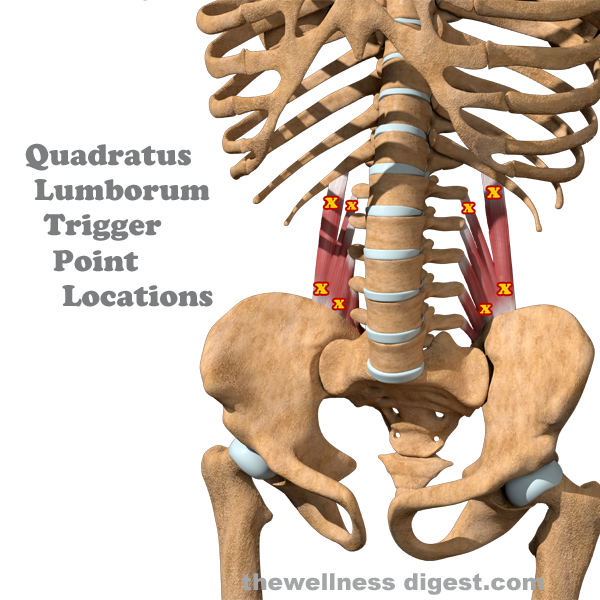
QL trigger points are relatively easy to find and treat. Many massage therapists, physical therapists, and chiropractors are trained in TrP therapy and can show you how to find and treat the specific TrPs of the quadratus lumborum.
If you are interested in learning how to self-treat, The Trigger Point Therapy Workbook is an excellent how-to book. It describes the TrP phenomenon and includes diagrams showing TrPs' locations and how to treat them.
NOTE: If you plan to use the workbook, you will need one of these tools for treatment.
The first is massage balls. The balls are used by placing the ball between you and the wall. The ball applies pressure to the TrP. You gently roll the ball around to massage the muscle. The Kieba Massage Lacrosse Balls are the right size and hardness to get the job done.
The other tool often used is the Thera Cane Massager. The Thera Cane is used on the QL muscle to treat one particular TrP that cannot be treated with a massage ball. It is also recommended for those who have mobility or balance problems as you do not have to lean and balance against a wall to treat the muscle.
Treatment consistency is vital to deactivate trigger points entirely. QL muscles respond best to 2-3 treatments of 1-2 minutes spread throughout the day.
Using Cold and Heat for QL Back Pain
Heat on muscle aches and pains feel good. Heat packs are your friend and your worst enemy! Heat treatments reduce your pain and stiffness, so more is better, right? Sorry, but the answer is no. Heat does promote relaxation, but it can also cause inflammation in the area, which is a primary contributor to muscle pain. Camping out on a heating pad feels good, but the pain roars back once you remove the heat. Heat treatments should last 20 minutes, 30 minutes tops, no longer.
The best treatment course is to alternate between hot and cold treatments. Yes, you think ice treatments are torture because they are so darn cold. The secret to a cold pack treatment is to endure the first 1-2 minutes, after which you will be surprised. It will start to feel good. The next secret to a cold pack treatment is to leave it on for 20 minutes only. Longer duration, and you risk damaging the skin and soft tissues.
How to alternate cold and warm treatments
Apply a cold pack after trigger point treatments for 20 minutes. After at least an hour passes, apply a warm pack for 20 minutes. You can do this multiple times during the day. It is important to wait at least an hour when switching treatments because if you apply the alternate treatment too soon, it will reduce the benefit of treatment.
Support and Compression
Heat does promote relaxation, but it can also cause inflammation in the area, which is a primary contributor to muscle pain. The compression provided by the brace supports the lower back, reducing pain and increasing mobility. The brace band should be wide and have side straps to fully support the QL muscle and easily adjust the compression amount.
How To Avoid Development of Trigger Points In The QL Muscles
- When lifting, use your legs for power. Don't rely on your back, shoulder, and arm muscles for strength.
- Never twist at the waist while lifting. Secure the item, then turn the body using your legs.
- Limit sitting time, get up, walk around and stretch. If you have a desk job, consider investing in a standing desk to alternate standing and sitting through the day.
- Evaluate your mattress. Does it provide support, or do you sink into the mattress while sleeping? Sleeping on an overly soft bed contributes to back pain and muscle pain throughout the body.
- Be aware of body mechanics and your conditioning level when playing sports. Golf, tennis, baseball, kayaking, and other activities that require hard twisting movements at the waist are problematic for the QL muscle.
- Horseback riding on a whole is good for strengthing back muscles. However, it is still sitting. Add to that, the QL muscle is working to stabilize and balance the upper body with the lower body, and that can cause the muscles to be overworked. If you are going for a long ride, get off periodically to walk. Your back and your horse will thank you!
Products We Use and Recommend For Quadratus Lumborum Muscle Pain
There are cheaper braces, but none better.
 If you have low back pain or need abdominal support, the Professional's Choice Back Brace will help reduce your pain and stiffness. The waist wrap and 2 side straps are easily adjusted and provide support compression to the low back and abdomen. It is the only low back brace TWD recommends. It works!
If you have low back pain or need abdominal support, the Professional's Choice Back Brace will help reduce your pain and stiffness. The waist wrap and 2 side straps are easily adjusted and provide support compression to the low back and abdomen. It is the only low back brace TWD recommends. It works!

Doctors and physical therapists often recommend TENS to relax muscles and ease the pain. The Belifu TENS Unit Muscle Stimulator is an excellent choice for treating back and hip pain.
 Cureve Hot Cold Pack can be used for warm and cold treatments. It is recommended that you use cold packs for injuries, swelling, and after a TrP treatment. Use a warm treatment when the muscle is tight and needs to relax.
Cureve Hot Cold Pack can be used for warm and cold treatments. It is recommended that you use cold packs for injuries, swelling, and after a TrP treatment. Use a warm treatment when the muscle is tight and needs to relax.
 Sombra Warm Therapy Gel is recommended for relaxing muscles and relieving pain. It warms without the burning heat of other gels. An excellent choice for pain caused by trigger points, muscle/joint over-use and stiffness, and arthritis. (Not sold in stores)
Sombra Warm Therapy Gel is recommended for relaxing muscles and relieving pain. It warms without the burning heat of other gels. An excellent choice for pain caused by trigger points, muscle/joint over-use and stiffness, and arthritis. (Not sold in stores)
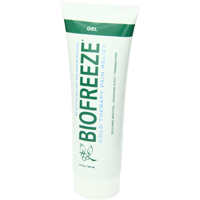 Biofreeze Professional Gel is recommended for the pain and symptoms of muscle strains. It provides excellent pain relief and may help reduce inflammation caused by a strain. Recommended by medical professionals and trainers.
Biofreeze Professional Gel is recommended for the pain and symptoms of muscle strains. It provides excellent pain relief and may help reduce inflammation caused by a strain. Recommended by medical professionals and trainers.
References:
Clay, J. H., Allen, L., Pounds, D. (2015). Clay & Pounds' Basic Clinical Massage Therapy: Integrating Anatomy and Treatment (3rd ed.). Philadelphia, PA: Lippincott Williams & Wilkins
Davies, C,. Davies, A., (2013). The Trigger Point Therapy Workbook: Your Self-Treatmend Guide For Pain Relief (3rd ed.). Oakland, CA: New Harbinger Publications
Finando, D., Finando, S. , (2005). Trigger Point Therapy for Myofascial Pain: The Practice of Informed Touch (1st ed.) Rochester, VT: Healing Arts Press.
Muscolino, J., (2016) Kinesiology: The Skeletal System and Muscle Function (3rd ed.). Maryland Heights, Missouri: Mosby.
Image Credit: Depositphotos
If you liked it, please share it!




